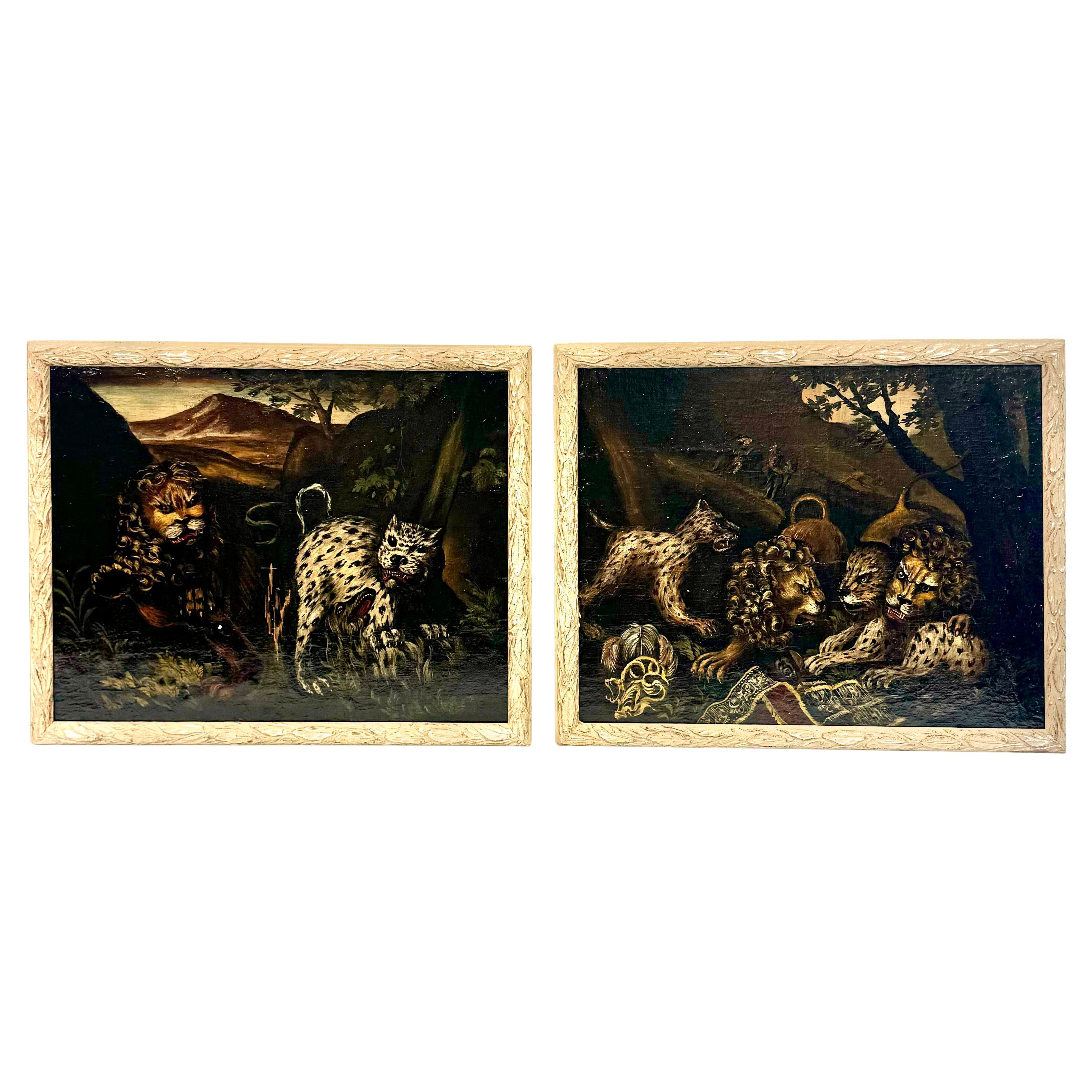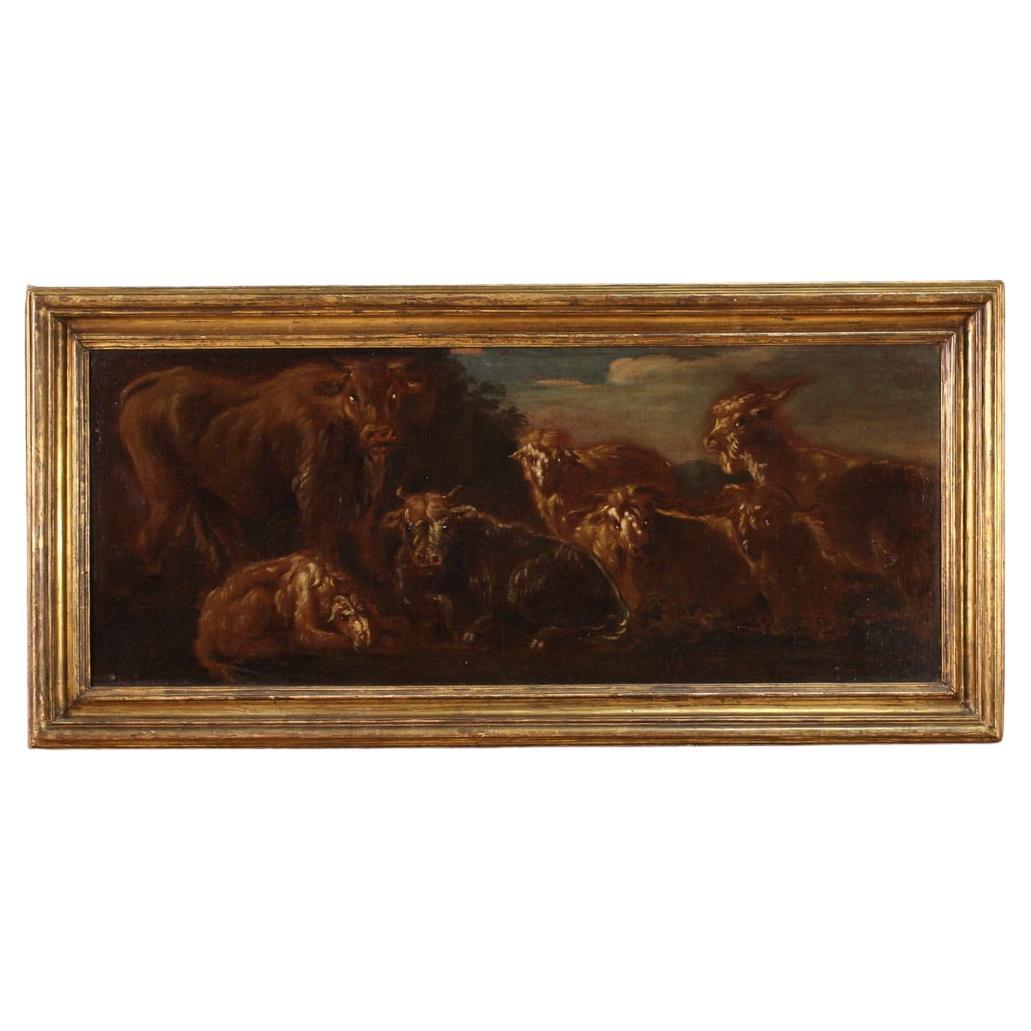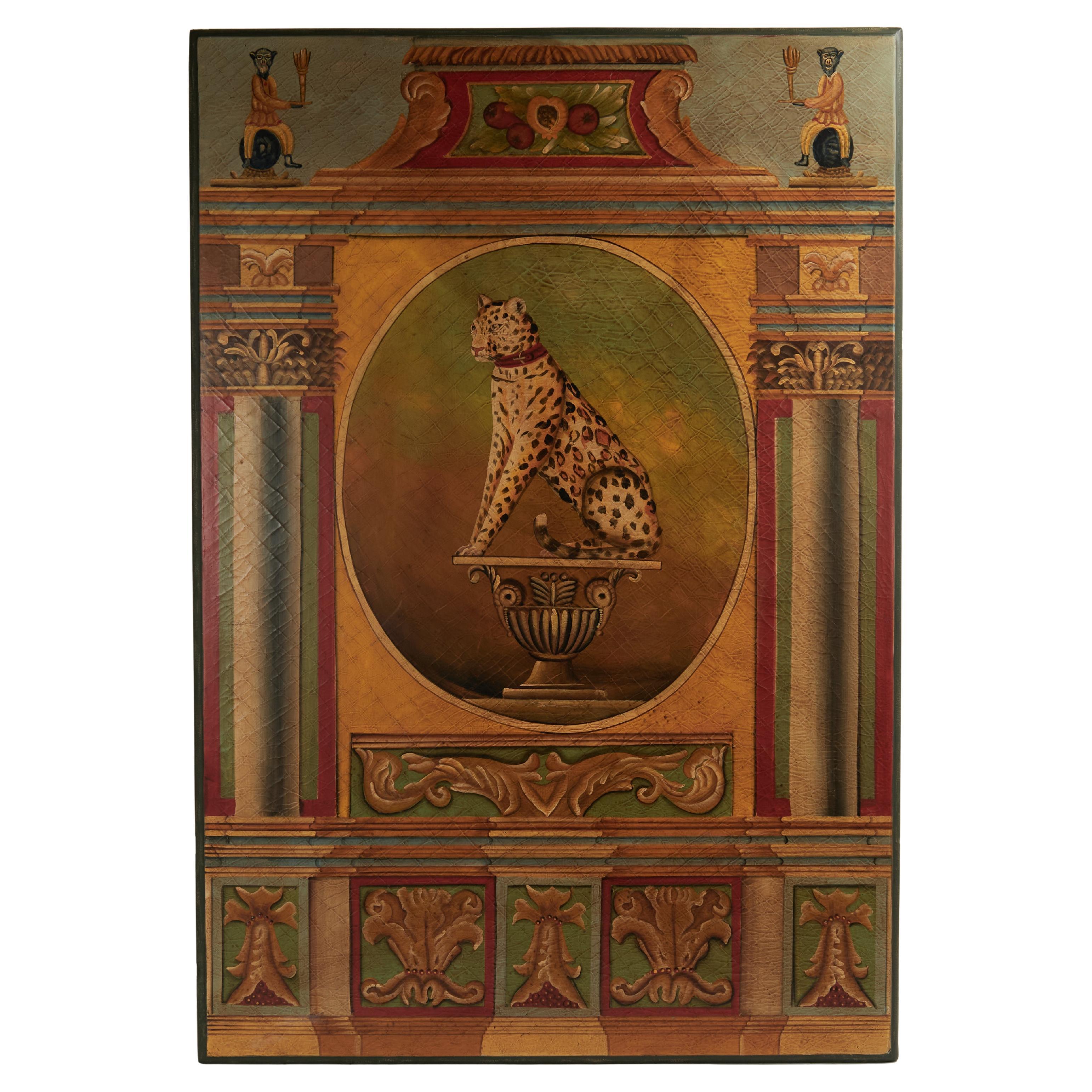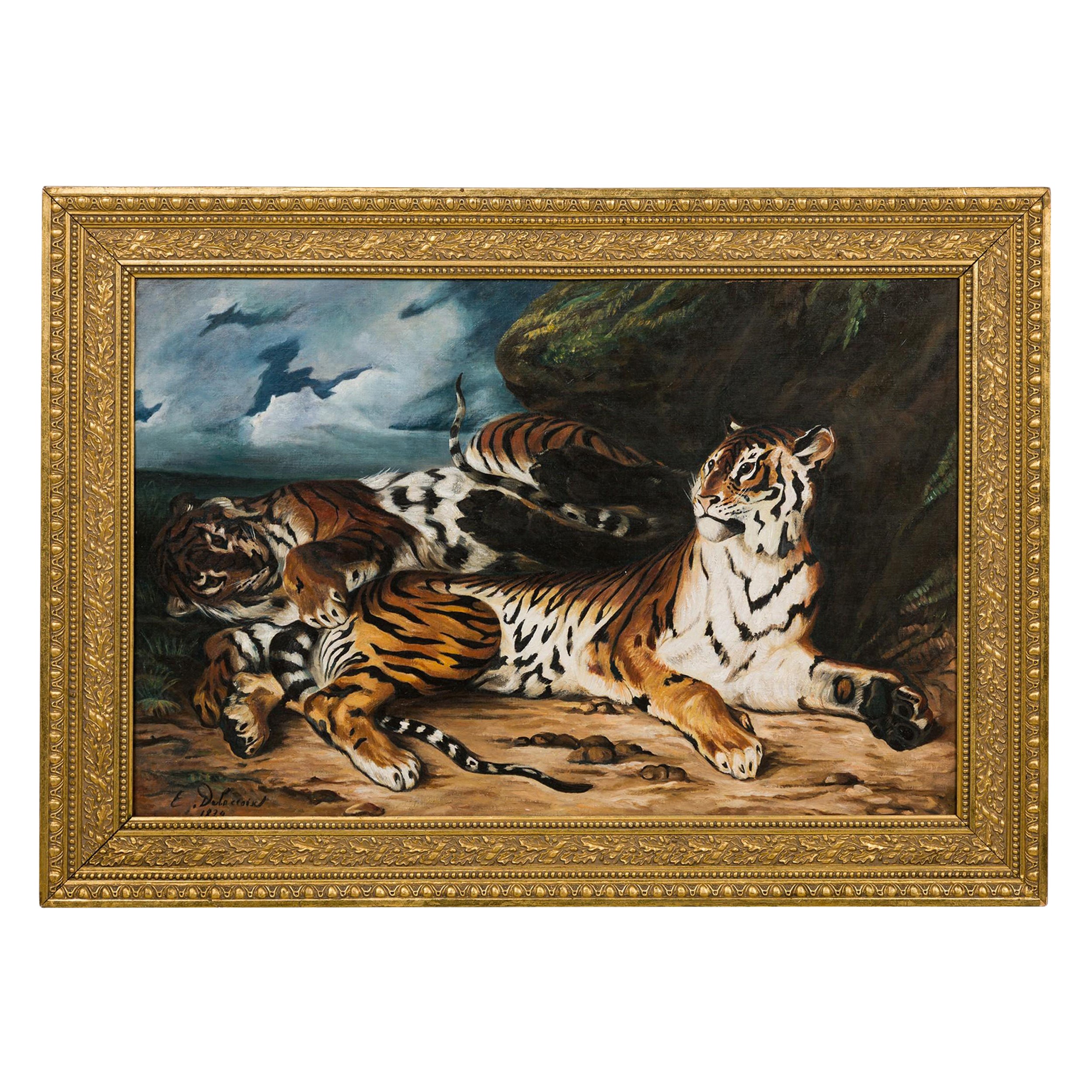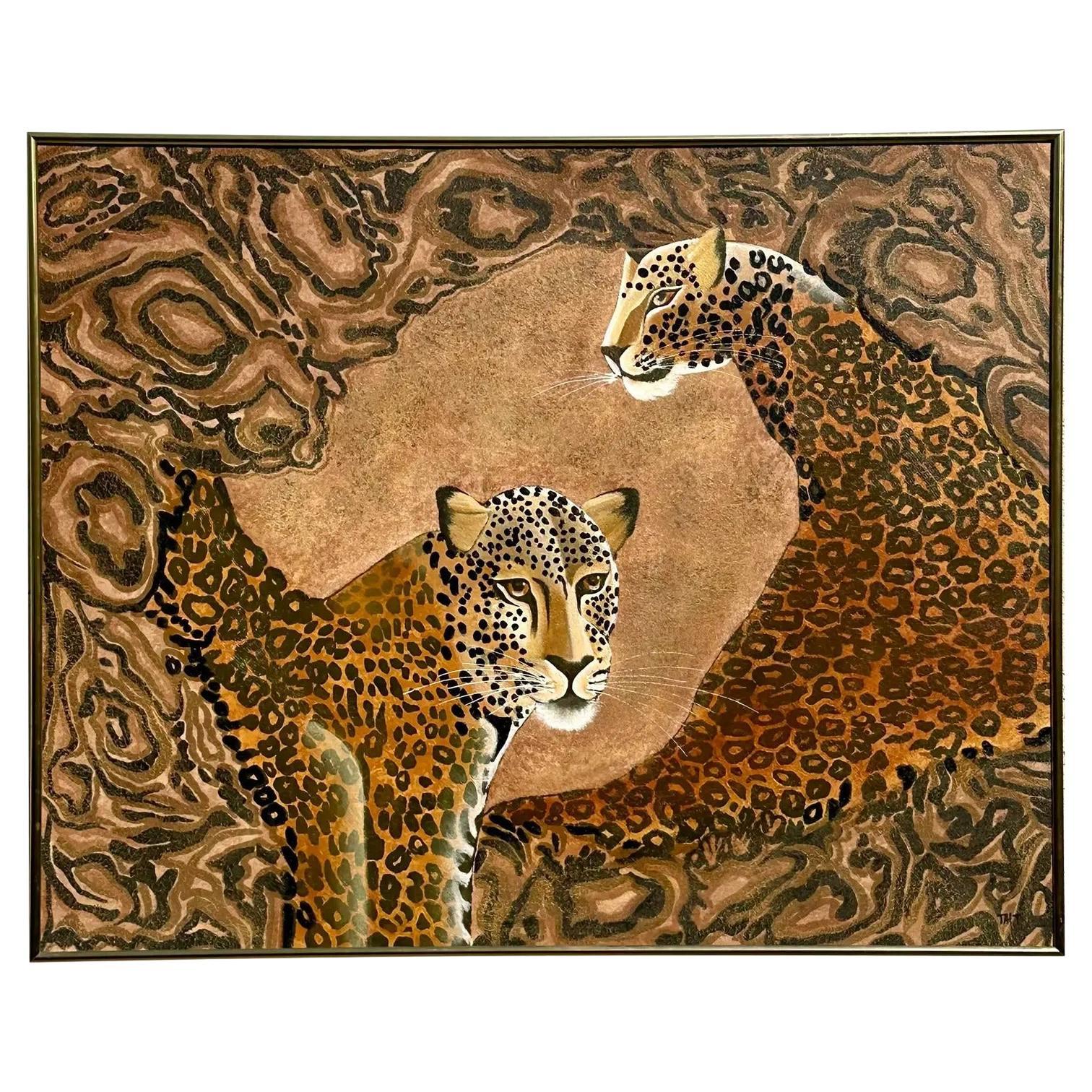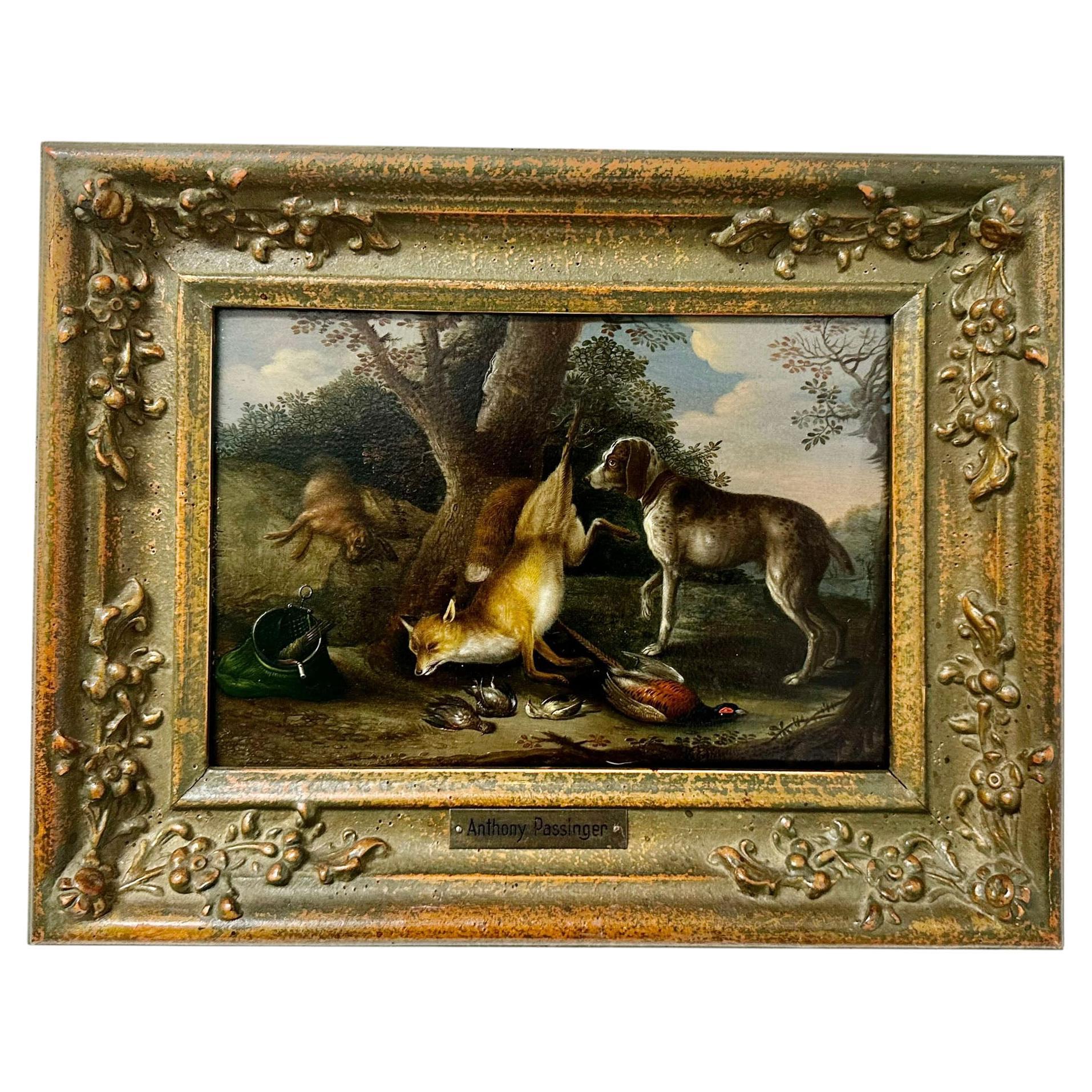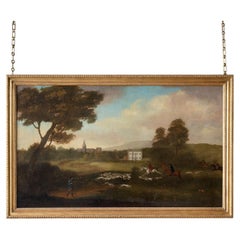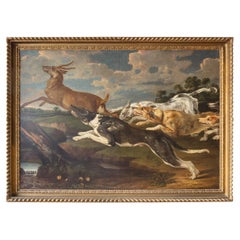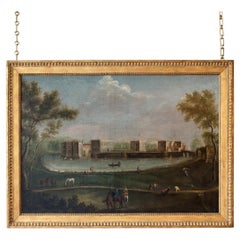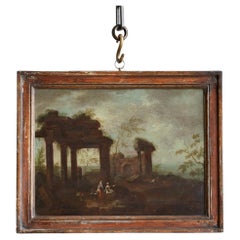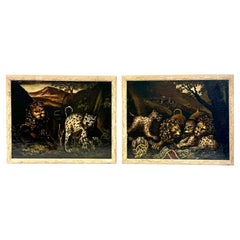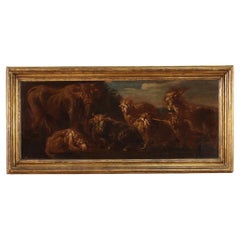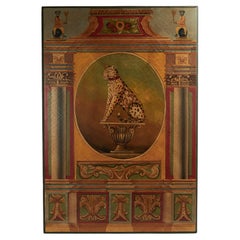Items Similar to Oil on Canvas; Large Scale Landscape Depicting Leopardess, Lioness, Wolf & Hare
Want more images or videos?
Request additional images or videos from the seller
1 of 6
Oil on Canvas; Large Scale Landscape Depicting Leopardess, Lioness, Wolf & Hare
$103,730.22
£75,000
€88,621.71
CA$143,370.72
A$159,437.81
CHF 83,683.53
MX$1,944,267.38
NOK 1,057,593.91
SEK 991,536.43
DKK 661,461.68
About the Item
A mid 17th century large scale oil on canvas depicting a Leopardess, a Lioness and a Wolf toying with a Dead Hare in an Arcadian landscape; in the style of the Dutch Golden Age ‘Animaliers’ and the circle of Frans Snijders.
Large canvases of hunting scenes, often featuring exotic animals such as leopards and lions, were initially popularised by the celebrated painter and diplomat Sir Peter Paul Rubens (1577-1640), and rapidly became a fixture of seventeenth-century patrician residences across Europe. They were heirs to the Renaissance tradition of tapestries representing hunts, which had long been a form of princely decoration, but had typically required much greater expenditures of time and money.
A monumental Wolf and Fox Hunt painted by Rubens in about 1616 – now in New York’s Metropolitan Museum – is considered one of the master’s earliest forays into this genre (fig. 1), alongside a set of four large hunting scenes originally executed for Elector Maximilian of Bavaria (c. 1616), featuring a Hippopotamus and Crocodile Hunt (Alte Pinakothek, Munich); a Wild Boar Hunt (Musée des Beaux-Arts, Marseilles); a Tiger Hunt (Musée des Beaux-Arts, Rennes); and a Lion Hunt destroyed by fire in Bordeaux in 1870. This type of composition – with its energetic treatment of the subject, its references to exotic and powerful beasts and its vibrant atmosphere – immediately appealed to patrons and was enthusiastically embraced by artists both within and outside Rubens’ immediate circle.
Among the former were fellow Flemish painters Frans Snyders (1579-1657) and his brother-in-law Paul de Vos (c. 1591-1678), each of whom collaborated with Rubens on important commissions, while also pursuing the genre of hunting scenes as part of their respective studio practices. Indeed, both are now predominantly remembered for their dynamic representations of hunts, which – differently to Rubens’ – chiefly focus on the animals, without the presence of human figures. This characteristic is shared by the present composition, which highlights the interaction between the beasts themselves, their feral nature and proximity enhancing the scene’s dramatic undercurrent. The wolf on the left, baring its teeth to defend its prey, is carefully observed, including its blood-shot eyes, salivating mouth, and thick fur, which all find parallels in compositions by Rubens and his circle (fig. 2). Similarly, the lioness emerging from behind a tree trunk in the background is a citation from a famous composition by Rubens and Jan Brueghel the Elder, The Garden of Eden with the Fall of Man (c. 1617, The Mauritshuis, The Hague; fig. 3), which in turn reprised Jan Brueghel the Elder’s Entry of the Animals into Noah’s Ark from 1613 (The J. Paul Getty Museum, Los Angeles). Finally, the leopard lying in the grass on the right derives from one of the predators in The Leopards by Snyders, an early work now in the Manchester Art Gallery (fig. 4). The presence of grapes at the animal’s feet has been linked to the fact Snyders often included fruit in his pictures of dead game, but here it may also be connected to the fact leopards were traditionally associated with the god of wine Bacchus, and as such repeatedly appear in painterly representations of his triumph.
To conclude, the present canvas belongs to the tradition of hunting scenes established in the seventeenth century by Rubens and his circle, and closely echoes the focus on animals found in the canvases of Snyders and de Vos. Its technique is also reminiscent of that by the two artists, identified by short and distinctive brushstrokes to describe animal fur and a somewhat more impressionistic handling of vegetation (the latter was sometimes executed by their contemporary and collaborator Jan Wildens, who specialised in landscape painting).
- Dimensions:Height: 62.6 in (159 cm)Width: 96.86 in (246 cm)Depth: 2.37 in (6 cm)
- Materials and Techniques:
- Place of Origin:
- Period:Mid-17th Century
- Date of Manufacture:circa 1650
- Condition:Wear consistent with age and use.
- Seller Location:London, GB
- Reference Number:1stDibs: LU848142243682
About the Seller
No Reviews Yet
Vetted Professional Seller
Every seller passes strict standards for authenticity and reliability
Established in 2001
1stDibs seller since 2008
34 sales on 1stDibs
Typical response time: 21 hours
- ShippingRetrieving quote...Shipping from: Mitcham, United Kingdom
- Return Policy
Authenticity Guarantee
In the unlikely event there’s an issue with an item’s authenticity, contact us within 1 year for a full refund. DetailsMoney-Back Guarantee
If your item is not as described, is damaged in transit, or does not arrive, contact us within 7 days for a full refund. Details24-Hour Cancellation
You have a 24-hour grace period in which to reconsider your purchase, with no questions asked.Vetted Professional Sellers
Our world-class sellers must adhere to strict standards for service and quality, maintaining the integrity of our listings.Price-Match Guarantee
If you find that a seller listed the same item for a lower price elsewhere, we’ll match it.Trusted Global Delivery
Our best-in-class carrier network provides specialized shipping options worldwide, including custom delivery.More From This Seller
View AllOil on Canvas; Hunting Scene, Circle of Francis Sartorius I (British, 1734-1804)
Located in London, GB
This bucolic representation of the English countryside, animated by a hunting scene in the foreground, is characteristic of the tradition for sporting pictures that developed in Brit...
Category
Antique Late 18th Century English Paintings
Materials
Paint
Oil on Canvas; Hounds Chasing a Stag, Studio of Frans Snyders, Antwerp 1579-1657
By Frans Snyders
Located in London, GB
This powerful hunting scene is closely associated to the work of Antwerp-born seventeenth century painter and draughtsman Frans Snyders, widely considered the “progenitor of Flemish Baroque still-life and animal painting.”
Having grown up surrounded by artists, Snyders was initially apprenticed to Pieter Brueghel the Younger (1564-1637/38), scion of a well-established family of painters. Like many of his contemporaries in Northern Europe, to complete his education he then travelled to Italy, staying mainly in Rome and Milan (1608-09). Once back in Flanders, his profile as a skilled young painter – who had refined his craft by studying the masters of Italian art – came to the attention of Sir Peter Paul Rubens (1577-1640), in whose Antwerp studio Snyders entered as an assistant in about 1610, and with whom he would go on to collaborate on a number of important commissions for years to come. In 1611, Snyders further strengthened his ties with the local community of painters by marrying Margaretha de Vos, sister to Cornelis and Paul de Vos, two artists with whom he would also regularly collaborate.
Thanks to the lessons learned in Italy and in Rubens’ studio, Snyders soon achieved the ability to create rhythmic and dynamic compositions, infused with vibrant colours and powerful naturalistic effects. Centred on the theme of the still life, his market scenes and representations of richly stocked pantries and larders embodied the buoyant and confident spirit of seventeenth-century Antwerp, a trading port with a wealthy merchant class and aristocracy (Still Life with Dead Game, Fruits, and Vegetables in a Market, 1614, The Art Institute of Chicago; Still-Life with Fowl and Game, 1614, Wallraf-Richartz Museum, Cologne). Flowers from all seasons and dead game are portrayed alongside baskets overflowing with fruit, precious gilt vessels and Chinese Wanli porcelain...
Category
Antique Early 17th Century Belgian Paintings
Materials
Paint
Oil on Canvas; The West Prospect of Leeds Castle, Kent, 18th Century British
Located in London, GB
This carefully observed view of Leeds Castle, enlivened by an array of figures and animals moving across its verdant grounds and medieval moat, is an important testimony of the build...
Category
Antique Mid-18th Century English Paintings
Materials
Paint
Capriccio of Architectural Ruins, Oil on Panel Painting, Early 18th Century
Located in London, GB
An Early 18th Century Oil on Panel Capriccio of Architectural Ruins
In later frame with small brass hanging loop, showing an arcadian landscape setting, with shepherds and their dog...
Category
Antique Early 18th Century Paintings
Portrait of a Hound within a Landscape
Located in London, GB
Oil on canvas. English, late 18th-early 19th century.
Category
Antique Late 18th Century English Paintings
Materials
Paint
A 19th Century Oil on Paper on Wooden Panel, Painting of a Calf in a Barn
Located in London, GB
A charming, small-scale painting of a brown and white calf.
Category
Antique 19th Century English Paintings
Materials
Paint
You May Also Like
Pair Of Italian School Lions and Leopards Paintings
Located in Bradenton, FL
Pair of stunning 17th / 18th Century Italian School oil on canvas mounted on board paintings of Lions and Leopards. Italian artists incorporated ele...
Category
Antique 18th Century Italian Baroque Paintings
Materials
Wood
17th Century Oil on Canvas Italian Landscape with Animals Painting, 1680
Located in Vicoforte, Piedmont
Antique Italian painting from the second half of the 17th century. Artwork oil on canvas depicting a particular subject Grazing animals of good pictorial quality in the style of Rosa...
Category
Antique 1680s Italian Paintings
Materials
Canvas
Huge Vintage Neoclassical Painted Panel with a Leopard and Monkeys
Located in Palm Beach, FL
Lofty vintage acrylic painting on wood of a fanciful composition with columns, ornaments, a leopard on a pedestal and monkeys executed in a tongue in cheek neoclassic trompe-l'oeil t...
Category
20th Century Italian Neoclassical Paintings
Materials
Acrylic
Study of Tigers Wildlife Painting
Located in Queens, NY
Copy of a wildlife painting titled "Study of Tigers"
Category
Late 20th Century American Victorian Paintings
Materials
Paint
Vintage Boho Signed Original Oil Painting of Cheetahs
Located in West Palm Beach, FL
A fabulous vintage Boho original oil painting. A handsome pair of cheetahs in repose. Signed by the artist. Acquired from a Palm Beach estate.
The...
Category
Late 20th Century North American Paintings
Materials
Paint
19th Century German Oil Painting
Located in Tampa, FL
Anton Passinger was an Austrian artist born in 1825. He died in 1900. The name is anglicized on the brass plaque, and it’s signed with his German signature on the back. The painting ...
Category
Antique 1890s German Paintings
Materials
Paint
More Ways To Browse
Antique Noahs Ark
Hunt Tapestry
Tiger Tapestry
Antique Dutch Trunk
Lion Toy
The Triumph Of Bacchus
Trunk Crocodile
Rubens Tapestry
Paul De Vos
Tiger Toy
Maximilian Fur
Antique Serpentine Dresser
Antique Stag Painting
Antique Sunderland
Antique Tiffany Clocks
Antique Window Screens
Antique Wood Ducks
Bakelite Furniture Pulls
